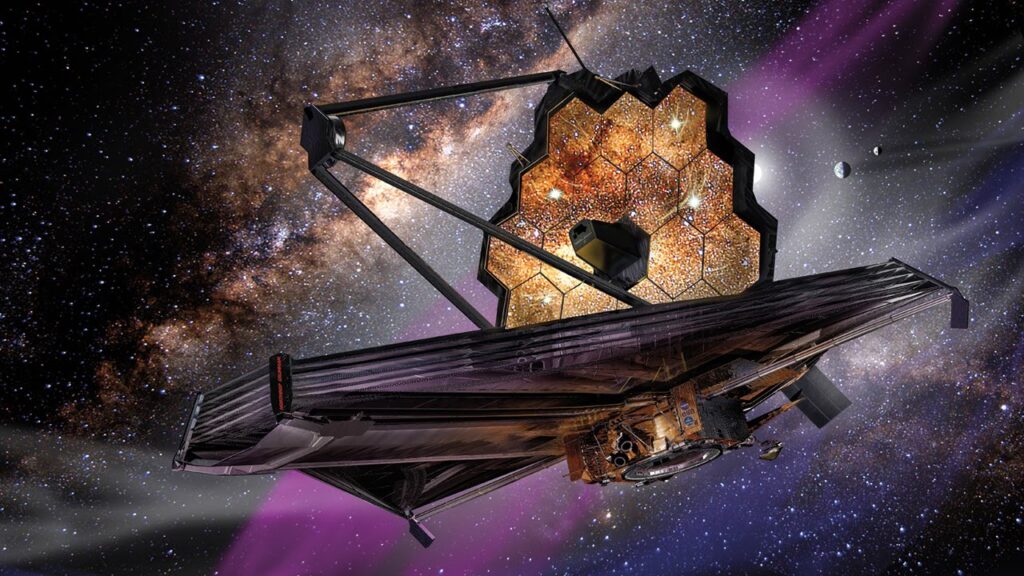James Webb Telescope
Revealing the Universe: How JWST’s Findings Are Changing Our Understanding of It
Astronomers have been using instruments like Hubble for decades to look into space and piece together the vast history of the universe’s creation and development. With the launch of the James Webb Space Telescope (JWST), an incredible feat of contemporary engineering, we are seeing a universe that is far richer and more intricate than we could have ever imagined. Even though some of its findings go against what we now know, they nonetheless present an exciting chance for scientific advancement rather than a collapse.
Table of Contents

Examining the Early Universe: An Uncertain Cosmic Timeline
James Webb Telescope
Observing the first stars and galaxies to form after the Big Bang is one of the main goals of the JWST. The key to understanding how the world changed from being a hot, dense soup of particles to the huge and organised universe we know today lies in these ancient celestial objects.
James Webb Telescope
Astronomers are baffled by preliminary JWST findings. Images of galaxies that appear remarkably big and mature, existing billions of years before projected by current models of cosmic evolution, have been captured by it. These findings imply that the formation of galaxies might have happened considerably more quickly and intricately than previously believed.
Past Galaxies: Revealing Exoplanet Climates
James Webb Telescope
The JWST observes more than simply the far past. Additionally, it can examine the atmospheres of exoplanets, which are planets circling stars outside of our solar system. By examining these atmospheres, scientists may assess if a planet is potentially habitable by looking for evidence of water vapour and other components necessary for life as we know it on Earth.
Water vapour has already been found by the JWST in the atmosphere of a hot, gaseous exoplanet. Even if this doesn’t prove that life exists, it does pave the way for more investigation and the discovery of potentially habitable worlds that are genuinely similar to Earth.
Enhancing Our Cosmic Toolbox: JWST’s State-of-the-Art Technologies
James Webb Telescope
The JWST’s cutting-edge technology makes it a game changer. This is what makes it unique:
- Infrared Vision: The JWST is particularly good at capturing infrared light, in contrast to Hubble, which mostly observes in the visible and ultraviolet spectra. This gives it the ability to look through clouds of dust and farther into space, revealing objects that were previously out of sight.
- Unmatched Sensitivity: The JWST’s potent sensors have unparalleled sensitivity, enabling it to identify faint spectral signatures and objects from far-off galaxies and exoplanets.
- Unmatched Resolution: With its large mirror and sophisticated optics, the JWST produces crisper images than any other spacecraft, allowing for in-depth research on astronomical objects.
James Webb Telescope
These developments expand our understanding of the universe by enabling astronomers to collect data with never-before-seen detail.
A Cosmic Web of Opportunities: Accepting the Challenge
James Webb Telescope
Although the JWST’s findings may contradict what we now know about the universe, this is not reason for hopelessness. It’s an exhortation to improve our models, investigate novel ideas, and learn more about the secrets of the cosmos. This is why the results of the JWST are intriguing:
- Fueling Curiosity: These findings pique our interest and motivate more study, which pushes us to create novel hypotheses and explanations for the universe’s evolution.
- Unexpected Findings: When we question accepted notions, sometimes the biggest discoveries arise. The JWST could inspire whole new ideas about the universe.
- A More Complete Picture: We can build a more comprehensive picture of the history and composition of the cosmos by combining JWST data with observations from other telescopes.
James Webb Telescope
The goal of the JWST is not to destroy all of our knowledge. It exists to offer us a fresh viewpoint and a more refined lens with which to see the cosmos. With greater data analysis and observations, we should be able to arrive at a more sophisticated and breathtaking understanding of the universe.


